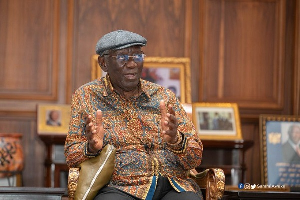 Former President John Agyekum Kufuor
Former President John Agyekum Kufuor
GhanaWeb feature by Ishmael Batoma
Former President John Agyekum Kufuor’s endorsement of the presidential candidate of the New Patriotic Party (NPP), Dr. Mahamudu Bawumia, over the weekend has divided the public.
Kufuor's comments have sparked a debate about his own legacy as president, with many drawing in the country attaining the status of a Highly Indebted Poor Country (HIPC) under his watch.
While some argue that the former president taking Ghana to HIPC was a strategic move to propel the country’s development, others hold the view that the move was an embarrassment for the country and that all the relief the country got from it was squandered by the Kufuor government, leaving the country in a worse state.
But was HIPC a blessing or a curse to Ghana? This article looks at the status of Ghana that was handed over to Kufuor and the Ghana he left behind.
What is HIPC?
The Heavily Indebted Poor Countries (HIPC) initiative is a programme by the International Monetary Fund (IMF) and the World Bank that provides debt relief to countries with high levels of poverty and debt.
The benefits of HIPC to beneficiary countries include debt relief (cancellation of loan repayment) from the IMF and other creditors, as well as grants and interest-free loans from the IMF, World Bank, and other creditors.
The Ghana Kufuor inherited:
Former President John Agyekum Kufuor took over from the first President of Ghana’s 4th Republic, the late Jerry John Rawlings, on January 7, 2001.
After a little over one year of taking over, Kufuor's government began the process to join the HIPC initiative, citing internal and external debts that culminated in a resurgence of domestic inflation and the steep and unprecedented depreciation of the country’s currency, the cedi, it inherited from the previous government.
The weak economic fundamentals the government cited included an inflation rate of 40.5% as of the end of December 2000 (up from 13.8% recorded in December 1999); a GDP growth rate of 3.7% in 2000 compared to 4.4% in 1999. The cedi at the end of 2000 depreciated by about 90%.
Also, the country’s debt stood at about US$7.50 billion (41.10 trillion old cedi). Excerpts of the 2021 Budget Statement indicated that out of the country’s total debt, US$5.80 billion (₵31.70 trillion) was external and ₵9.40 trillion (US$1.7 billion) was domestic. The total debt represented 224% of the country's exports, 709% of budget revenue, and 124% of the country's Gross Domestic Product (GDP).
A report by the Bank of Ghana also indicates that, as at the end of 2000, “Ghana’s public and publicly guaranteed debt reached US$6.0 billion in nominal terms, including arrears of US$81 million. Ghana’s external debt in net present value terms reached US$3.9 billion, representing about 571% of fiscal revenue, about 157% of exports of goods and non-factor services, and about 78% of GDP.”
What HIPC brought Ghana:
The HIPC programme led to the cancellation of about US$3.7 billion of Ghana’s external debts of about US$6.0 billion, which is about 56% of the country’s total debt.
The Bank of Ghana gives a breakdown of Ghana’s debt cancellation as follows:
“In 2002, Ghana received debt relief amounting to US$275.2 million, out of which US$109.0 million was credited to the HIPC account at the Bank of Ghana. In 2003, the country enjoyed debt relief of US$290.8 million, and US$318.3 million as at November 2004, out of which US$109 million and US$167.1 million were credited to the HIPC account respectively.
“After Ghana reached the flexible completion point in July 2004, her external debt was expected to remain below the NPV of debt-to-government revenue threshold of 250% established under the HIPC Initiative. The NPV of expected external debt would be US$2.9 billion.
“After completion point, the country is expected to benefit from additional debt relief as indicated by bilateral creditors, which would further reduce the external debt stock to US$2.4 billion.”
In effect, the HIPC programme greatly reduced Ghana’s external debt burden. It led to a drastic reduction in the debt service-to-revenue ratio from 79.8% in 2000 to 7.6% in 2003.
It is also instructive to note that instead of repaying its external debts, the HIPC programme allowed the Kufuor government to invest some of the loan money in education, healthcare, and government policies.
The Ghana Kufuor left:
Kufuor's 8-year reign ended in 2008 with a real GDP growth rate of 6.2%. The inflation rate stood at 18.1% as at December 2008.
Also, as of the end of December 2008, the cedi had depreciated by 30%. Ghana’s debt rose to US$8 billion before Kufuor left office, despite all the debt relief his government got under the HIPC programme. This debt level was more than the one Kufuor came to meet.
According to the 2009 Budget, the over US$8 billion debt “consisted of 49% and 51% of external and domestic debts, respectively.”
Watch the latest episode of Everyday People on GhanaWeb TV below:
You can also watch a compilation of today's Twi news below: